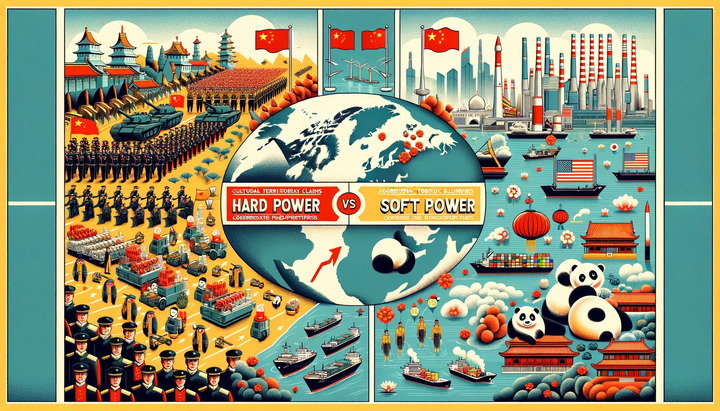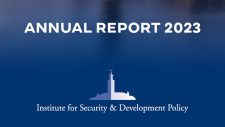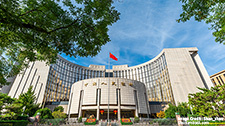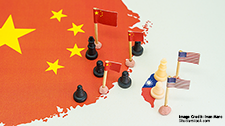Hegemony at a Crossroads: The Inverse Dynamics of China’s Global Strategy

Brian Iselin
Here is my bold statement. Hard power projection decimates soft power but only for authoritarian states.
In the early 21st century, I was living in Beijing and at that time China was lauded as an emerging global power, but mostly deftly using soft power to make friends, establish markets, and achieve economic success. It was a time of, let’s call it, Zhu Rongji or Li Peng thought. Zhu was China’s Premier from 1998 to 2003, preceded for a decade by Li, during a period of significant post-Tiananmen social and economic reforms and development in China. Their tenures were marked by efforts to modernise China’s economy, tackle corruption, and reduce inefficiencies within the state-owned enterprises. And an emphasis on projecting soft power. It was not hard power projection at all.
Fast forward to the present day, and China’s strategy has taken a stark, darker, more malign turn towards the use of hard power, manifesting in military assertiveness and coercive diplomacy. This shift has resulted in a noticeable erosion of trust and international goodwill because of, what we would call in games theory, China’s “chronic defections”. What these last 20-odd years suggest to me is an inverse relationship between hard and soft power.
Let’s explore this a little. First, the two important definitions for clarity:
- Hard Power: A measure of military and coercive actions.
- Soft Power: A measure of diplomatic influence, cultural appeal, and economic partnerships.
While democratic nations like the US, the EU, Canada, France, Japan, South Korea, and the UK have managed to balance significant levels of both hard and soft power, it would be my contention that this dynamic plays out differently for authoritarian states. In countries where power is centralised and governance is less transparent, and foreign policy ends are expressed in military adventurism crossing global relations norms, soft and hard power are at odds with each other; the journey to expressing hard power can come only at the expense of soft power. It might be unfair, but there it is.
This article focuses on this phenomenon within authoritarian regimes, specifically China (although it can apply equally to Russia, and most recently Israel). I exclude North Korea from this as it has never had the soft power to trade. I aim to explore, moving towards a more widely applicable theory, how China’s increasing reliance on hard power strategies will lead to a decline in their global influence and the onset of significant international pushback. China’s alienation and “surrounding” is the probable and, to be candid, predictable outcome of their own strategy. China is making a rod for their own back.
The Inverse Relationship Between Hard and Soft Power Under Authoritarianism
China’s initial rise was characterised by its use of soft power—cultural diplomacy, economic partnerships, and participation in global institutions. However, as China’s economic and military capabilities grew, so did its willingness to exercise hard power. This shift can be visualised in a way that illustrates the inverse relationship between hard and soft power over time.
This chart, below, although based on somewhat hypothetical “plucked out of the air” data, shows a clear trend: as China’s hard power increases, its soft power diminishes. The factors contributing to this shift are quite innumerable, but inter alia aggressive territorial claims, trade practices perceived as unfair by other global powers, overt irredentism, increasing defections from normative behaviour, rising domestic authoritarianism, and a lack of transparency in its economic policies.
Soft power relies on attraction and persuasion. Autocratic hard power undermines both. With an emphasis on hard power, attraction morphs to fear, persuasion to coercion. I believe that this inverse relationship between hard and soft power can be visually represented. The data points will be harder, but possible, to define. Let’s try a line chart where one line (representing hard power) goes up, while the other line (representing soft power) goes down.
Let’s create that chart to illustrate this concept. We’ll assume the following data points to demonstrate the trend over time. We start with some hypothetical (but not extreme) data. While guesstimates, I believe it would be time well-spent to arrive at a method to index hard and soft power.
| Year | Hard Power | Soft Power |
| 2000 | 20 | 80 |
| 2005 | 30 | 70 |
| 2010 | 40 | 60 |
| 2015 | 50 | 50 |
| 2020 | 70 | 30 |
| 2025 | 90 | 20 |
Now, let’s pop those data points on a line chart:
Indicators of the Tipping Point
As you can see, there is a crossover, or tipping, point where the exercise of hard power disproportionately reduces the impact of and undermines soft power. To understand whether China has reached a tipping point in its relations with the EU and the US, just as two examples, we could consider several key indicators. These indicators highlight the growing friction and defensive measures taken by these global powers in response to China’s assertive strategies.
Let me try to tabulate what we might use as measures.
Table of Potential Indicators of the Tipping Point
| Indicator | EU-China Trade Context | US-China Trade Context |
| Trade Imbalances | Significant trade deficit with China | Persistent trade deficit despite tariffs |
| Defensive Trade Measures | Anti-subsidy tariffs and trade barriers | Tariffs and trade war |
| Geopolitical Realignments | Shift in diplomatic stance on issues like Taiwan | Strengthening alliances in the Indo-Pacific |
| Market Diversification | EU companies seeking alternatives to Chinese suppliers | US companies diversifying supply chains away from China |
| Public Opinion and Perception | Negative perception of China’s trade practices | Increasing public and political support for decoupling |
| Bilateral Trade Agreements | Stalled or slow progress in trade agreements | Renegotiation of trade deals with a focus on fairness |
| Economic Sanctions | Potential for increased sanctions and trade restrictions | Ongoing and potential new sanctions |
| Cultural Influence Decline | Reduced influence of Chinese cultural exports | Declining enrolment of Chinese students and tourism |
| Human Rights Concerns | Criticism of China’s human rights record | Legislative measures addressing human rights issues |
Creating a scale to measure hard and soft power involves identifying key indicators for each type of power and assigning scores based on measurable criteria. Below is a conceptual scoring matrix that could be used to approximate real-life calculations of hard and soft power.
Scoring Matrix for Hard and Soft Power
Hard Power Indicators
- Military Expenditure (0-20 points)
- Low: 0-4
- Moderate: 5-10
- High: 11-15
- Very High: 16-20
- Number of Military Bases Abroad (0-10 points)
- None: 0
- Few (1-3): 2-4
- Moderate (4-7): 5-7
- Many (8+): 8-10
- Arms Exports (0-10 points)
- Low: 0-2
- Moderate: 3-6
- High: 7-10
- Coercive Diplomatic Actions (0-10 points)
- Rare: 0-2
- Occasional: 3-6
- Frequent: 7-10
Soft Power Indicators
- Cultural Influence (Media, Arts, Sports) (0-20 points)
- Low: 0-4
- Moderate: 5-10
- High: 11-15
- Very High: 16-20
- Educational Influence (International Students) (0-10 points)
- Low: 0-2
- Moderate: 3-6
- High: 7-10
- Diplomatic Network (Embassies, Alliances) (0-10 points)
- Limited: 0-2
- Moderate: 3-6
- Extensive: 7-10
- Economic Partnerships and Trade Agreements (0-10 points)
- Few: 0-2
- Moderate: 3-6
- Many: 7-10
Example Calculation
Let’s use the hypothetical data to score China:
Hard Power Score
- Military Expenditure: Very High (16 points)
- Number of Military Bases Abroad: Few (4 points)
- Arms Exports: High (7 points)
- Coercive Diplomatic Actions: Frequent (8 points)
Total Hard Power Score: 16 + 4 + 7 + 8 = 35
Soft Power Score
- Cultural Influence: Moderate (10 points)
- Educational Influence: High (7 points)
- Diplomatic Network: Extensive (10 points)
- Economic Partnerships and Trade Agreements: Many (10 points)
Total Soft Power Score: 10 + 7 + 10 + 10 = 37
Interpreting the Scores
- Hard Power Score (35): This high score reflects China’s significant military expenditure, number of military bases, arms exports, defections from good normative behaviour, weaponisation of trade, and frequent coercive diplomatic actions.
- Soft Power Score (37): Despite its strong hard power, China’s soft power remains substantial (but perhaps declining) due to its cultural influence, educational appeal, diplomatic network, and economic partnerships.
If these numbers would be borne out by a more systematic analysis (that someone should do!), we see China closing in on their own tipping point. By using a scoring matrix like this, we can quantify and compare the levels of hard and soft power for different countries. This approach provides a structured way to analyse and discuss the balance of power in international relations, offering insights into how shifts in strategy might impact a country’s global standing. And it takes it to the foothills of a predicative model, including laying out indicators of further change, and potentially triggers or mechanisms for changing the dynamic. And I would predict that at some point the two lines cross, and their relative decline and rise become self-perpetuating.
Implications for China at the Tipping Point
Reaching this tipping point carries significant implications for China, both positive and negative, but I would say more the latter. Understanding these implications requires a nuanced analysis of the benefits and drawbacks of China’s current trajectory.
Net Negative Implications
- Economic Isolation: Increased tariffs, trade barriers, and sanctions could isolate China economically, reducing its access to key markets and technology.
- Diminished Soft Power: The erosion of soft power could result in fewer diplomatic allies and reduced influence in international organisations.
- Supply Chain Vulnerability: As global companies diversify their supply chains, China could lose its position as the world’s manufacturing hub, impacting its economic stability.
- Geopolitical Tensions: Aggressive posturing in regions like the South China Sea and Taiwan could escalate into conflicts, straining China’s resources and further alienating other nations.
Net Positive Implications
- Domestic Consolidation: The focus on hard power could consolidate the Chinese government’s control internally, enhancing its ability to implement policies without external interference.
- Strategic Autonomy: By reducing reliance on Western markets and technology, China could develop greater self-sufficiency and resilience in key sectors.
- Regional Dominance: Increased military presence and assertiveness could cement China’s dominance in the Asia-Pacific region, altering regional power dynamics in its favour.
Conclusion
China’s shift from soft to hard power represents a significant strategic gamble. While it has enabled the country to project strength and secure its interests more aggressively, it has also led to increasing isolation and distrust on the global stage. And this dynamic will only worsen for China as it flexes. The tipping point, indicated by defensive measures from the EU and the US, along with broader geopolitical realignments, suggests that China may soon face the consequences of its hard power approach. The challenge for China will be to balance its assertive strategies with the need to maintain and rebuild its soft power, ensuring sustainable growth and stability in an increasingly interconnected world. Who cares anymore about things like Panda Diplomacy and Beijing Opera in the face of building military bases in international waters in the South China Sea? The latter overshadows the power of the former. Apparently, the current occupants of Zhongnanhai don’t care, for they surely must see it. Or it is precisely what Xi seeks.
So, the evidence points towards a complex and precarious future full of power trade-offs for China. Whether this trajectory will ultimately net benefit or net harm China depends on its ability to adapt and respond to reactions to its behaviour. Trust is a scarce but important commodity in global relations and every defection by China from global norms reduces trust, hamstringing their soft power capability. For authoritarian states, the two cannot co-exist. As the world watches closely, the decisions made in Beijing will undoubtedly influence the international order for years to come. The only real question is, will those influences be maleficent or beneficent?
Related Publications
-
The US and EU, and the Emerging Supply Chain Network: Politics, Prospects, and Allies
The Global Supply Chains have evolved from simply logistical achievements to being the bedrock of the global economy. Driven by technological advances and geopolitical shifts, this transformation underscores the critical […]
-
ISDP Annual Report 2023
ISDP’s Annual Report for the year 2023. We look back on 2023, a year in which tensions and conflicts captured the strategic space in ISDP’s focus areas, making headlines around […]
-
The Economic Leash: China’s Financial Tethers and Global Power Plays
China’s emphasis on Gross Domestic Product (GDP) growth and its integration into global markets have allowed it to wield significant influence internationally. Nonetheless, this focus on rapid expansion has created […]
-
China as a Black Sea Actor: An Alternate Route
China’s international role has expanded rapidly in the last decades, and the Greater Central Asian region, Europe, and the Middle East, to which the Black Sea region (BSR) connects, are […]
-
Taiwan-PRC Crisis: What Cross-Strait Conflict Could Cost Europe
The escalating tensions between Taiwan and China pose significant economic and strategic challenges to the European Union, such as the inaccessibility of Taiwanese inputs, market, and capital. This issue brief […]




